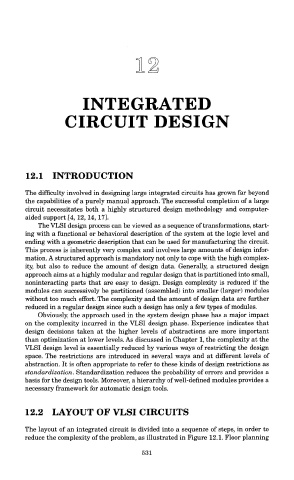Page 546 - DSP Integrated Circuits
P. 546
1 9
JL /-q
INTEGRATED
CIRCUIT DESIGN
12.1 INTRODUCTION
The difficulty involved in designing large integrated circuits has grown far beyond
the capabilities of a purely manual approach. The successful completion of a large
circuit necessitates both a highly structured design methodology and computer-
aided support [4,12, 14, 17].
The VLSI design process can be viewed as a sequence of transformations, start-
ing with a functional or behavioral description of the system at the logic level and
ending with a geometric description that can be used for manufacturing the circuit.
This process is inherently very complex and involves large amounts of design infor-
mation. A structured approach is mandatory not only to cope with the high complex-
ity, but also to reduce the amount of design data. Generally, a structured design
approach aims at a highly modular and regular design that is partitioned into small,
noninteracting parts that are easy to design. Design complexity is reduced if the
modules can successively be partitioned (assembled) into smaller (larger) modules
without too much effort. The complexity and the amount of design data are further
reduced in a regular design since such a design has only a few types of modules.
Obviously, the approach used in the system design phase has a major impact
on the complexity incurred in the VLSI design phase. Experience indicates that
design decisions taken at the higher levels of abstractions are more important
than optimization at lower levels. As discussed in Chapter 1, the complexity at the
VLSI design level is essentially reduced by various ways of restricting the design
space. The restrictions are introduced in several ways and at different levels of
abstraction. It is often appropriate to refer to these kinds of design restrictions as
standardization. Standardization reduces the probability of errors and provides a
basis for the design tools. Moreover, a hierarchy of well-defined modules provides a
necessary framework for automatic design tools.
12.2 LAYOUT OF VLSI CIRCUITS
The layout of an integrated circuit is divided into a sequence of steps, in order to
reduce the complexity of the problem, as illustrated in Figure 12.1. Floor planning
531

